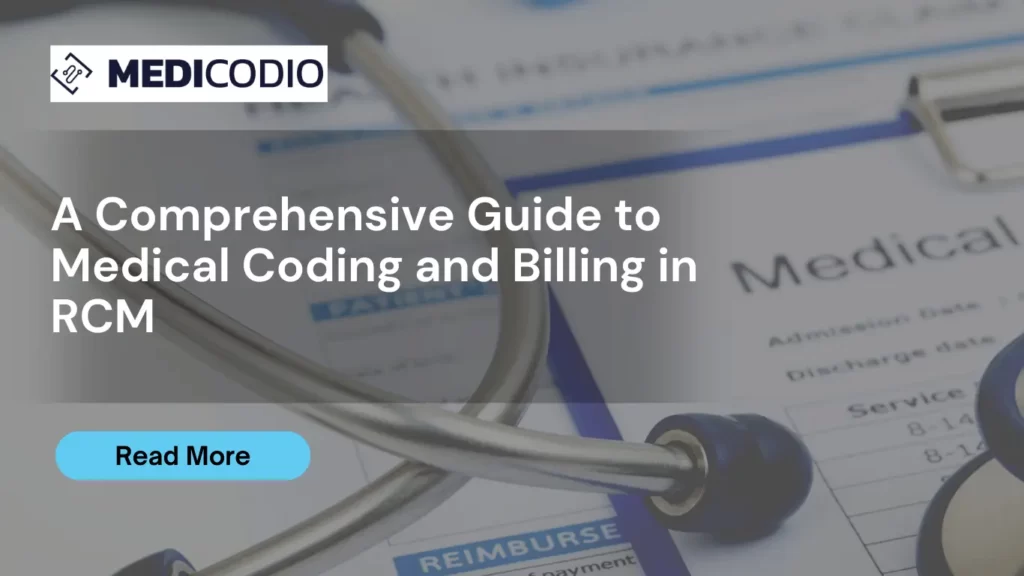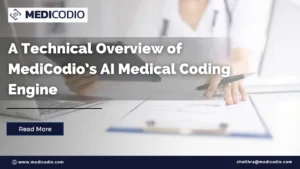What’s the difference between Medical Coding and Billing?
Let’s first understand, what is medical coding and medical billing?
Medical coding and billing are highly essential aspects of the healthcare and RCM industries that involve translating medical procedures, diagnoses, and services into standardized codes for documentation and reimbursement purposes.
Medical coding vs medical billing
Medical coding is the process of assigning specific alphanumeric codes to the diagnoses, procedures, and services provided during a patient’s healthcare encounter. These codes are based on the International Classification of Diseases (ICD) system for diagnoses and the Current Procedural Terminology (CPT) system for procedures. The purpose of medical coding is to ensure accurate and consistent recording of medical information for various purposes, including billing, research, and statistical analysis.
Medical billing, on the other hand, is the process of submitting coded medical information to insurance companies, government healthcare programs, or patients themselves to request payment for healthcare services rendered. Medical billers use the coded information to generate claims and invoices, which are then sent to the appropriate parties for reimbursement. They also follow up on unpaid or denied claims, communicate with insurance companies, and resolve any billing-related issues.
What is medical coding and billing in Revenue Cycle Management (RCM)?
In RCM, medical coding and billing encompasses the series of steps involved in managing the financial aspects of healthcare services. From patient registration to payment collection, the RCM cycle ensures the accurate and timely reimbursement of healthcare providers. It involves processes such as patient registration and eligibility verification, obtaining pre-authorization when necessary, assigning standardized codes to documented services through medical coding, claims submission and adjudication by insurance companies, payment processing, denial management and appeals, patient billing and collections, and reporting and analysis. Effective management of the RCM cycle is crucial for healthcare organizations to optimize revenue, ensure compliance with coding guidelines, minimize claim denials, and maintain financial stability.

How many steps are in RCM medical billing?
The RCM medical billing process typically consists of several steps. While the specific number of steps may vary depending on the organization and the intricacies of their billing practices, a typical RCM medical billing process can be broken down into the following steps:
- Patient Registration: Gathering and recording patient demographic information, insurance details, and relevant medical history.
- Eligibility Verification: Checking the patient’s insurance coverage and determining their eligibility for the services rendered.
- Pre-authorization: Obtaining prior authorization from the insurance company for certain procedures or treatments, if required.
- Coding: Assigning standardized codes to the procedures, diagnoses, and treatments documented in the patient’s medical records.
- Claims Generation: Creating claims that include the coded information, along with supporting documentation, to submit to the insurance company for reimbursement.
- Claims Submission: Sending the generated claims electronically or via paper to the appropriate insurance company or payer.
- Claims Adjudication: The insurance company reviews the claims, checking for accuracy, medical necessity, and compliance with coding guidelines. They determine the reimbursement amount based on the patient’s insurance plan.
- Payment Processing: Receiving reimbursement from the insurance company, which can include full or partial payment of the claim amount.
- Denial Management and Appeals: Managing and addressing claim denials by identifying the reasons for denial, rectifying any errors, and appealing if necessary to ensure proper reimbursement.
- Patient Billing and Collections: Billing the patient for any remaining balance after insurance reimbursement and actively managing collections.
- Reporting and Analysis: Monitoring and analyzing key performance indicators, such as revenue, claim denials, reimbursement patterns, and financial metrics, to evaluate the financial health of the organization and identify areas for improvement.
These steps represent a general overview of the RCM medical billing process, and specific organizations may have additional steps or variations based on their specific workflows and requirements.
Is medical coding and billing difficult?
The difficulty level of medical coding and billing can vary depending on various factors. Medical coding and billing require a solid understanding of medical terminology, anatomy, and coding systems such as ICD-10-CM and CPT. It involves interpreting complex medical documentation and accurately assigning the appropriate codes for diagnoses, procedures, and treatments. This process requires attention to detail, precision, and knowledge of coding guidelines and regulations.
Additionally, staying updated with ever-changing coding rules and regulations can be challenging. Mastering medical coding and billing may take time and extensive training. However, with proper education, training, and experience, individuals can develop the necessary skills to navigate this field effectively.
It’s important to note that there are resources available, such as coding books, AI tools, and industry certifications, to support professionals in their coding and billing tasks. With dedication and continuous learning, individuals can overcome the initial challenges and find success in the field of medical coding and billing.
Despite a good training, medical coders tend to make mistakes. Click here to check some of the common mistakes.
To learn about the consequences of mistakes in medical coding, please click here.
Why AI in Revenue cycle management important?
AI is sweeping across every industry; healthcare RCM is no exception. One area of the RCM cycle that AI has positively impacted is medical coding. Medical coding involves assigning standardized codes to medical procedures, diagnoses, and treatments for billing and reimbursement purposes.
One of AI’s greatest powers is its tireless learning capabilities. Through the process of machine learning, AI algorithms refine their understanding of medical codes, constantly improving their accuracy and efficiency. They absorb the collective wisdom of human coders, augmenting it with their own analytical prowess. Over time, they become the virtuosos of medical coding, able to navigate the labyrinthine paths of healthcare data effortlessly.
In this blog, we provide you answers to all your questions, such as: Why is medical coding important in the revenue cycle process? Is coding part of the revenue cycle? What is RCM coding? What are coding and revenue cycle management?
Process of medical coding in RCM cycle
- Gathering Information: The first step is to collect all the necessary medical documentation, such as patient charts, medical reports, and test results.
- Identifying Diagnoses and Procedures: The medical coder carefully examines the documentation to determine the relevant diagnoses and procedures related to the patient’s treatment.
- Selecting Codes: The medical coder chooses the appropriate codes from the relevant code set, such as ICD-10-CM for diagnoses and CPT/HCPCS for procedures.
- Implementing Codes: The selected codes are then entered into the patient’s medical record and billing system.
- Reviewing Accuracy: The medical coder carefully reviews the entered codes to ensure their accuracy and completeness, making any necessary corrections or additions.
- Submitting Claims: Once the coding is deemed complete and accurate, the medical coder submits insurance claims or bills to the appropriate payer for reimbursement.
- Follow-up: In some cases, the medical coder may need to follow up with the payer to ensure that the claim is processed and paid correctly.
Why AI medical coding and billing tool is important for RCM companies?
There are several reasons; some of them are:
- Cost Savings: By automating medical coding processes, RCM companies can reduce costs associated with manual coding. AI tools eliminate the need for extensive coding training and can handle high volumes of coding tasks without the need for additional human resources.
- Compliance and Audit Readiness: AI coding tools are designed to adhere to the latest coding guidelines and regulations. They stay updated with coding changes, ensuring compliance with industry standards. This capability helps RCM companies maintain accurate and audit-ready coding practices, reducing the risk of compliance issues and potential financial penalties.
- Efficiency and Accuracy: AI medical coding tools can process vast amounts of medical data quickly and accurately. They use machine learning algorithms to analyze medical records and automatically assign appropriate codes. This automation reduces the time and effort required for manual coding, improving efficiency and minimizing errors.
- Consistency and Standardization: AI coding tools provide consistent coding practices across different coders and healthcare facilities. They follow predefined rules and coding guidelines, minimizing variations in coding choices. This consistency improves the accuracy of claims submissions, reduces claim denials, and enhances overall revenue cycle performance.
- Real-Time Analytics and Insights: AI coding tools can analyze coding patterns and trends from a vast dataset. By extracting meaningful insights, RCM companies can identify areas for improvement, optimize coding processes, and make data-driven decisions. These analytics help in revenue optimization, cost reduction, and streamlining operations.
- Adaptability to Coding Updates: Coding guidelines and regulations regularly change, requiring continuous training and updates for human coders. AI coding tools can adapt to these updates more efficiently and quickly, ensuring accurate coding practices without extensive retraining.
In summary, AI medical coding and billing tools offer RCM companies increased efficiency, accuracy, cost savings, compliance, standardization, real-time insights, and adaptability. These benefits contribute to improved revenue cycle management, streamlined operations, and enhanced financial performance for healthcare organizations.
Experience the Power of AI in medical coding and billing with CODIO’s Free Plan! Unlock the full potential of AI by signing up for CODIO’s Free 30-day trial!
Sign up here, right now: https://core.medicodio.com/login
About MEDICODIO
MediCodio offers an AI-based medical coding automation solution provider dedicated to simplifying medical coding and billing workflows. We offer AI-powered medical coding assistant, CODIO, to healthcare organizations, ambulatory centers, and RCM companies. Powered by deep learning and machine learning, CODIO suggests medical codes automatically by reading patient information from EHR systems, physician notes and charts. The platform’s wide range of features include a CPT/ICD code search function, detailed dashboards, NCCI Edit checks, seamless API integrations, and automated data entry. With CODIO, users can accelerate the code selection process, reduce errors, claim denials, turnaround time, and expenses in medical coding workflows.





